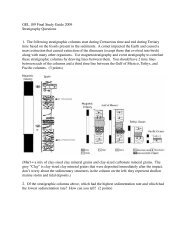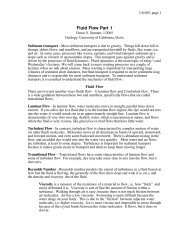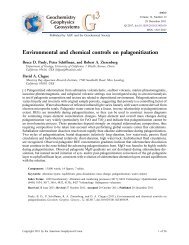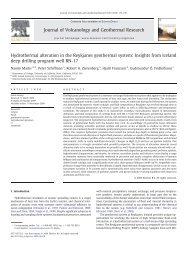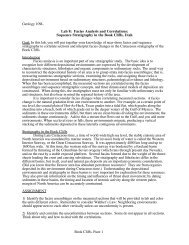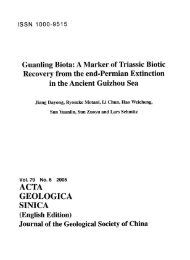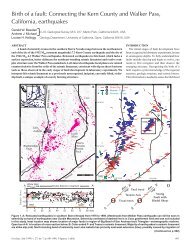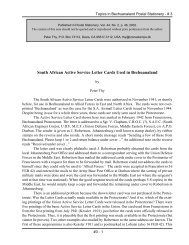Lab 2: Stratification, Sedimentary Structures - MyGeologyPage
Lab 2: Stratification, Sedimentary Structures - MyGeologyPage
Lab 2: Stratification, Sedimentary Structures - MyGeologyPage
Create successful ePaper yourself
Turn your PDF publications into a flip-book with our unique Google optimized e-Paper software.
Geology 109L, Dawn Y. Sumner<br />
<strong>Lab</strong> 2: <strong>Stratification</strong>, <strong>Sedimentary</strong> <strong>Structures</strong><br />
and Interpretation of Paleocurrents<br />
Goal: The goal of this lab is to examine sedimentary structures in rocks and interpret the<br />
processes that formed them.<br />
Suggested Reading:<br />
Chapter 4 in Sedimentology & Stratigraphy (p. 37-61)<br />
*Useful pages for Part 1: Sections 4.7-4.9 (p. 58-60)<br />
*Useful pages for Part 2: Sections 4.2.4- 4.6 (p. 41-58)<br />
Chapter 3 in <strong>Sedimentary</strong> Rocks in the Field (p. 28-125)<br />
*Useful pages for Part 1: p. 34-40, 68-100<br />
*Useful pages for Part 2: p. 30, 46-67<br />
Introduction<br />
<strong>Sedimentary</strong> structures are the result of a variety of depositional processes and are found<br />
within beds, on the tops of beds, and on the bases of beds. These structures reflect the<br />
predominant environmental conditions at the time of deposition and are important tools for the<br />
interpretation of those environments. <strong>Structures</strong> can show us the mechanics of fluid flow, the<br />
direction of flow, paleobiological aspect of the environment, and early compactional forces.<br />
Some structures will show us which way was up during deposition. Others destroy earlier<br />
structures, i.e. burrowing organisms erase ripple stratification in some cases. <strong>Structures</strong> can be<br />
depositional, erosional, or post-depositional. They can be biogenic or abiogenic. Many<br />
sedimentary structures are due to a combination of processes.<br />
One of the most common sedimentary structures is stratification, which is the layering of<br />
the sediments on the scale of less than a millimeter to many meters. <strong>Stratification</strong> can often be<br />
recognized by changes in mineralogy, color, or grain size that mark surfaces. The geometry of<br />
these surfaces and their spatial relationships to each other are characteristic of different<br />
sedimentary structures and styles of deposition.<br />
Erosional <strong>Structures</strong><br />
Erosion occurs on the tops of beds when the fluid flowing over them is fast enough to lift<br />
grains off the sediment bed. The structures are created on top of the bed, and the next layer of<br />
sediment fills in the topography on the surface forming casts of the erosional structures. The<br />
structures commonly are recognized as casts because it can be difficult to prove that an erosive<br />
structure formed during deposition of the rock rather than during weathering. In contrast, casts<br />
of structures had to have formed prior to deposition of the sediment forming the cast. These are<br />
some common erosional structures:<br />
1) Flute casts: Flutes form when eddies in turbulent flow touch the sedimentary surface (i.e. the<br />
viscous boundary layer breaks down due to excessive turbulence). The deep narrow<br />
portion points upstream. It flares and shallows downstream, and is typical in the Tb and<br />
Tc portion of a Bouma sequence. They are usually recognized as casts.<br />
<strong>Sedimentary</strong> <strong>Structures</strong>, Page 1
2) Ridge, furrow, and gutter casts: Ridges, furrows, and gutters are elongate features on the tops<br />
of beds form from turbulence. They are very elongate and do not have the well defined<br />
up-stream scour that flutes show. Thus, they indicate the trend of the current, but do not<br />
usually tell you the direction of flow. Ridges and furrows are on the scale of mm wide,<br />
whereas gutters are on the scale of cm. They can be meters long.<br />
3) Channels: These are large scale scours which are usually filled with coarser sediment than the<br />
material the channel cuts into. River channels are an example of how large channels can<br />
be.<br />
4) Obstacle scour marks: These form downstream of objects sitting on a sedimentary surface.<br />
The object produces eddies, creating high flow areas with enhanced erosion and low flow<br />
areas with enhanced deposition.<br />
5) Grooves: Grooves form when objects such as sticks or rocks are dragged along the surface<br />
by the flow. The shape and size of the groove depends on the shape and size of the<br />
object.<br />
6) Impact or bounce marks: These form when an object hits sediment and bounces off or skips.<br />
Impacts can be meteor-size down to pebble-size. These structures are common in the Tb<br />
and Tc portion of a Bouma sequence. Raindrop impact structures are a special subset of<br />
these structures that form when a scattered drops hit layers of dry mud or silt.<br />
Depositional <strong>Structures</strong><br />
Depositional structures form in response to the flow characteristics of the depositing fluid<br />
and the conditions of deposition.<br />
1) Bedding is the smallest lithostratigraphic unit. It is simply a package of sediment > 1cm in<br />
thickness that has some sort of change above and below it, like a compositional or abrupt<br />
grain size change.<br />
2) Lamination is < 1 cm in thickness, and is defined by changes in grain size, color or<br />
mineralogy.<br />
3) Cross-stratification appears as sets of laminae that truncate older laminae within a bed.<br />
Cross-stratification can form from infilling of channels and scours, or by the migration of<br />
dunes and ripples. Cross-stratification forms in silts, sands, and conglomerates and is a<br />
very useful indicator of flow conditions. Younger laminae always cross cut older<br />
laminae, so you can tell which way is up. Features that vary include:<br />
a. The size range of cross-lamination and cross-stratification<br />
b. The shape of cross-stratification/lamination: See the text book and photos on the web<br />
page to get a sense of the different types. Note that the 2-d shape of cross stratification<br />
varies substantially with the orientation of the surface you are looking at relative to the<br />
<strong>Sedimentary</strong> <strong>Structures</strong>, Page 2
flow direction. Thus, to fully understand the shape of cross-stratification, you need to<br />
look at least 2 surfaces that are perpendicular to each other and imagine the 3-d shape of<br />
the bedforms.<br />
4) Ripples, dunes and sand wave forms can be preserved on bedding surfaces. Usually, the<br />
migration of the bedforms destroys the surfaces, but in some cases, ripple crests are<br />
preserved by burial with sediment in the absence of erosion. You have a number of these<br />
samples in lab. When the crests of ripples are preserved, it is easier to tell their origin.<br />
However, you can also infer ripple type from the cross lamination within the sediment.<br />
5) Graded Beds show a grain size change from the bottom of a bed to the top. Normally<br />
graded bedding is coarser material at the base of the bed that fines up. Reversely graded<br />
bedding is fine material grading up to coarser material. These structures show the change<br />
in energy in the transport system.<br />
5) Massive beds: as the name implies, these beds have no apparent internal structures. You may<br />
see evidence of bioturbation, dewatering or recrystallization. When the divisions<br />
between beds are unclear and they lack distinctive structures, we call them amalgamated.<br />
Post Depositional <strong>Sedimentary</strong> <strong>Structures</strong><br />
These features occur after the sediments are deposited, but usually before lithification. They do<br />
not include regional types of deformation, such as faulting and folding.<br />
1) Slumps and slides occur on an inclined surfaces and show folding and thrusts in the<br />
sediments.<br />
2) Deformed bedding is disrupted, convoluted or contorted beds. Cross-stratification and<br />
lamination is deformed.<br />
3) Load structures form by one bed sinking into the one below it. Flame structures form when<br />
mud is injected into overlying sands. Ball and pillar structures form when sand sinks<br />
into mud and forms a defined blob. Dish and pillar structures form when sand sinks into<br />
a previously deposited sandstone. These structures are common at the base of submarine<br />
flow deposits like turbidites.<br />
4) Mudcracks and syneresis cracks: Mudcracks are polygonal patterns in sediment and can be<br />
any size. They are caused by desiccation in a wet-dry environment. The fine silt or clay<br />
laminae shrink and crack, which then allows sediments to later fill in the cracks.<br />
Syneresis cracks occur subaqueously due to dewatering of sediments resulting from changes<br />
in salinity. They are usually spindle-shaped incomplete polygons.<br />
Biogenic <strong>Sedimentary</strong> Features<br />
Biogenic features are caused by the activity of organisms in the sediments. Using the biological<br />
evidence available in the rocks can make determining the environment much easier.<br />
<strong>Sedimentary</strong> <strong>Structures</strong>, Page 3
1) Trace fossils are marks in the sediment that result from organisms crawling, feeding,<br />
excreting and burrowing in or on the sediment. When well preserved, they are distinctive<br />
indicators of specific organisms and have taxonomic classification just as the organism<br />
itself does. They can be very helpful in determining age relations and facies analysis.<br />
2) Bioturbation is the process of mixing sediment as organisms crawl around feeding and<br />
burrowing in the sediment. Generally, it homogenizes beds, erasing other sedimentary<br />
structures. Sometimes defined burrows can be preserved, but commonly bioturbated<br />
beds have a mottled or massive appearance. Bioturbation can also occur from plant roots.<br />
<strong>Sedimentary</strong> <strong>Structures</strong>, Page 4
Geology 109L<br />
<strong>Lab</strong> 2: <strong>Sedimentary</strong> <strong>Structures</strong><br />
Name:<br />
TA:<br />
Part 1: Erosional, post-depositional, and biological structures. Photographs posted on the<br />
class web page will help you identify the structures in your lab samples.<br />
1. T-1326<br />
a) Sketch the cut surface of this rock and part of the bottom of the rock. Name both of the<br />
structures. Include a scale.<br />
b) Name the rock types and give the grain sizes at the top of the sample and at the base of the<br />
sample (Hint: there are 2 different rock types in this sample).<br />
c) Briefly describe how the structures formed.<br />
2. T-1355 (G106-48) Decide which direction is up.<br />
a) Sketch this rock with up towards the top of the page. Include a scale.<br />
<strong>Sedimentary</strong> <strong>Structures</strong>, Page 5
) Name the sedimentary structure.<br />
c) Name the rock.<br />
3. SS71 (G106-61)<br />
a) Sketch the bottom of this rock and name the sedimentary structure. Include a scale.<br />
b) Add an arrow to your sketch to indicate the paleocurrent direction suggested by this structure.<br />
c) In what sedimentary environment would this structure likely form?<br />
d) Name the rock and give the grain size.<br />
4. CC-1 Note the granule-sized mudrock rip-up clasts in this sample.<br />
a) Sketch the bottom of this rock and name the sedimentary structure. **This sedimentary<br />
structure is common at the base of the turbidites we will see on our second field trip and was<br />
collected at our field trip site.<br />
<strong>Sedimentary</strong> <strong>Structures</strong>, Page 6
) What is the difference between the base of this sample and sample SS71? How might the<br />
flow have been different?<br />
c) This bed was collected in an area with abundant turbidites. Which part of the Bouma<br />
sequence does this sample contain? (Answer this question after Part 2)<br />
d) Name the rock and give the grain size.<br />
5. P-3457<br />
a) Sketch part of the base of this bed and name the structures. Include a scale.<br />
b) Name the rock type that fills the structures and the rock type that surrounds the structures.<br />
Give the grain size of each.<br />
c) Describe the sequence of events that produced this sample. (Hint: there are 5 steps)<br />
<strong>Sedimentary</strong> <strong>Structures</strong>, Page 7
6. SS76 and SS77 (GC 67)<br />
a) What are these sedimentary structures?<br />
b) What is the difference between the two examples?<br />
c) What can you say about the environment in which these structures formed?<br />
d) Name each rock. SS76:<br />
SS77:<br />
<strong>Sedimentary</strong> <strong>Structures</strong>, Page 8
Part 2: <strong>Stratification</strong> styles. For this part of the lab, it will be very helpful to use several<br />
movies produced by USGS geologists that show how stratification varies with the geometry of<br />
ripple and dune crests. These movies and an explanation of them are available both on the class<br />
web page and on the lab iBooks. Check out an iBook and review the movies before examining<br />
these samples. I have also posted numerous photos of cross stratification on the class web page,<br />
which will help you identify structures and understand their origins.<br />
7. T-1377 Top on this sample is the surface with the number.<br />
a) Sketch this rock with up towards the top of the page. Include a scale.<br />
b) What sedimentary feature is in this rock? What does it say about changes in flow speed with<br />
time?<br />
c) Name the rock. Include grain sizes.<br />
8. SS6 and SS9 Decide which direction is up for each of these rocks.<br />
a) Sketch each sample with up toward the top of the page. Show the shape of the upper surface<br />
and schematically sketch the dip of a few laminae relative to the shape of the upper surface.<br />
Include scales with each sketch.<br />
<strong>Sedimentary</strong> <strong>Structures</strong>, Page 9
) Add arrows to your sketches to indicate the paleocurrent directions suggested by these<br />
structures.<br />
c) Name the structures. What is the main difference in the water flow that deposited these<br />
samples?<br />
d) Name each rock and give the grains size. SS6:<br />
9. SS1<br />
a) Examine the surface with the sample number on it (the top). Name the sedimentary feature.<br />
SS9:<br />
b) What is the main difference between this structure and those in SS6 and SS9?<br />
c) What flow conditions produce this type of structure?<br />
d) Name the rock with grain size.<br />
10. SS52 Decide which direction is up.<br />
a) Sketch the sample with up toward the top of the page. Include two perpendicular surfaces to<br />
provide a 3-d view of the cross stratification. Include a scale.<br />
<strong>Sedimentary</strong> <strong>Structures</strong>, Page 10
) Add an arrow that shows the direction of flow.<br />
c) What shape do you think the dune crest had and why? (Hint: the USGS movies will be<br />
helpful.)<br />
d) Name the rock and give grain size.<br />
11. RB-1 Decide which direction is up before sketching this rock.<br />
a) Sketch this rock with up towards the top of the page. <strong>Lab</strong>el the two types of sedimentary<br />
structures. Include a scale.<br />
b) What changes in flow occurred based on the change in cross stratification in this sample?<br />
c) What shape do you think the ripple crests had and why? (Hint: the USGS movies will be<br />
helpful.)<br />
d) Name the rock and give grain size.<br />
<strong>Sedimentary</strong> <strong>Structures</strong>, Page 11
12. T-1451 Decide which direction is up before sketching this rock.<br />
a) Sketch this rock with up towards the top of the page. <strong>Lab</strong>el the two types of sedimentary<br />
structures. Include a scale.<br />
b) What changes in flow occurred based on the change in cross stratification in this sample?<br />
d) Name the rock.<br />
13. 106-HCS-1<br />
a) Sketch the surface of this sample that has the up arrow on it. Name the cross stratification<br />
type. Include a scale.<br />
b) Does the structure indicate a specific flow direction? Why or why not?<br />
c) Where might a deposit such as this be forming today?<br />
d) Name the rock and give grains size.<br />
<strong>Sedimentary</strong> <strong>Structures</strong>, Page 12



